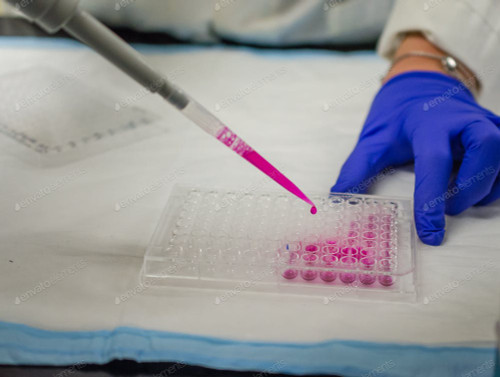Product Description
Recombinant Human Estradiol 17-beta-dehydrogenase 11 (HSD17B11) is available at Gentaur for Next week Delivery.
Gene Name: HSD17B11
Alternative Names : 17-beta-hydroxysteroid dehydrogenase 11;17-beta-HSD 11;17bHSD11;17betaHSD1117-beta-hydroxysteroid dehydrogenase XI;17-beta-HSD XI;17betaHSDXICutaneous T-cell lymphoma-associated antigen HD-CL-03;CTCL-associated antigen HD-CL-03Dehydrogenase/reductase SDR family member 8Retinal short-chain dehydrogenase/reductase 2;retSDR2Short chain dehydrogenase/reductase family 16C member 2
Expression Region : 20-300aa
AA Sequence : ESFVKLFIPKRRKSVTGEIVLITGAGHGIGRLTAYEFAKLKSKLVLWDINKHGLEETAAKCKGLGAKVHTFVVDCSNREDIYSSAKKVKAEIGDVSILVNNAGVVYTSDLFATQDPQIEKTFEVNVLAHFWTTKAFLPAMTKNNHGHIVTVASAAGHVSVPFLLAYCSSKFAAVGFHKTLTDELAALQITGVKTTCLCPNFVNTGFIKNPSTSLGPTLEPEEVVNRLMHGILTEQKMIFIPSSIAFLTTLERILPERFLAVLKQKISVKFDAVIGYKMKAQ
Sequence Info : Full Length of Mature Protein
Tag Info : N-terminal 6xHis-SUMO-tagged
Theoretical MW : 46.8 kDa
Storage Buffer : Tris/PBS-based buffer, 5%-50% glycerol. If the delivery form is lyophilized powder, the buffer before lyophilization is Tris/PBS-based buffer, 6% Trehalose, pH 8.0.
Endotoxin Level : Not tested-
Biological Activity : Not tested
Storage : Short term: -20°C; Long term: -80°C. Minimize freeze and thaw cycles.
Research Area : Metabolism
Restriction : For Research Use Only. Not for use in diagnostic procedures, drug use, or for administration to humans or animals.
Relevance : Can convert androstan-3-alpha,17-beta-diol (3-alpha-diol) to androsterone in vitro, suggesting that it may participate in androgen metabolism during steroidogenesis. May act by metabolizing compounds that stimulate steroid synthesis and/or by generating metabolites that inhibit it. Has no activity toward DHEA (dehydroepiandrosterone), or A-dione (4-androste-3,17-dione), and only a slight activity toward testosterone to A-dione. Tumor-associated antigen in cutaneous T-cell lymphoma.
Function : Can convert androstan-3-alpha,17-beta-diol (3-alpha-diol) to androsterone in vitro, suggesting that it may participate in androgen metabolism during steroidogenesis. May act by metabolizing compounds that stimulate steroid synthesis and/or by generating metabolites that inhibit it. Has no activity toward DHEA (dehydroepiandrosterone), or A-dione (4-androste-3,17-dione), and only a slight activity toward testosterone to A-dione. Tumor-associated antigen in cutaneous T-cell lymphoma.
Involvement in disease :
Subcellular location : Secreted
Protein Families : Short-chain dehydrogenases/reductases (SDR) family, 17-beta-HSD 3 subfamily
Tissue Specificity : Present at high level in steroidogenic cells such as syncytiotrophoblasts, sebaceous gland, Leydig cells, and granulosa cells of the dominant follicle and corpus luteum. In lung, it is detected in the ciliated epithelium and in acini of adult trachea, in bronchioles, but not in alveoli. In the eye, it is detected in the nonpigmented epithelium of the ciliary body and, at lower level, in the inner nuclear layer of the retina (at protein level). Widely expressed. Highly expressed in retina, pancreas, kidney, liver, lung, adrenal, small intestine, ovary and heart.
Paythway :
Uniprot ID : Q8NBQ5
 Euro
Euro
 British Pound
British Pound
 US Dollar
US Dollar








